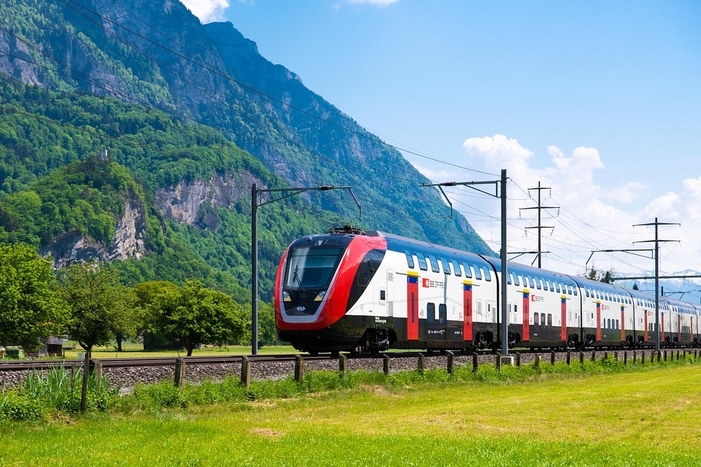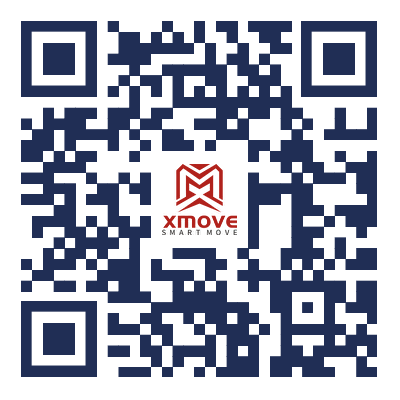Ultimate Guide to Swiss Railways
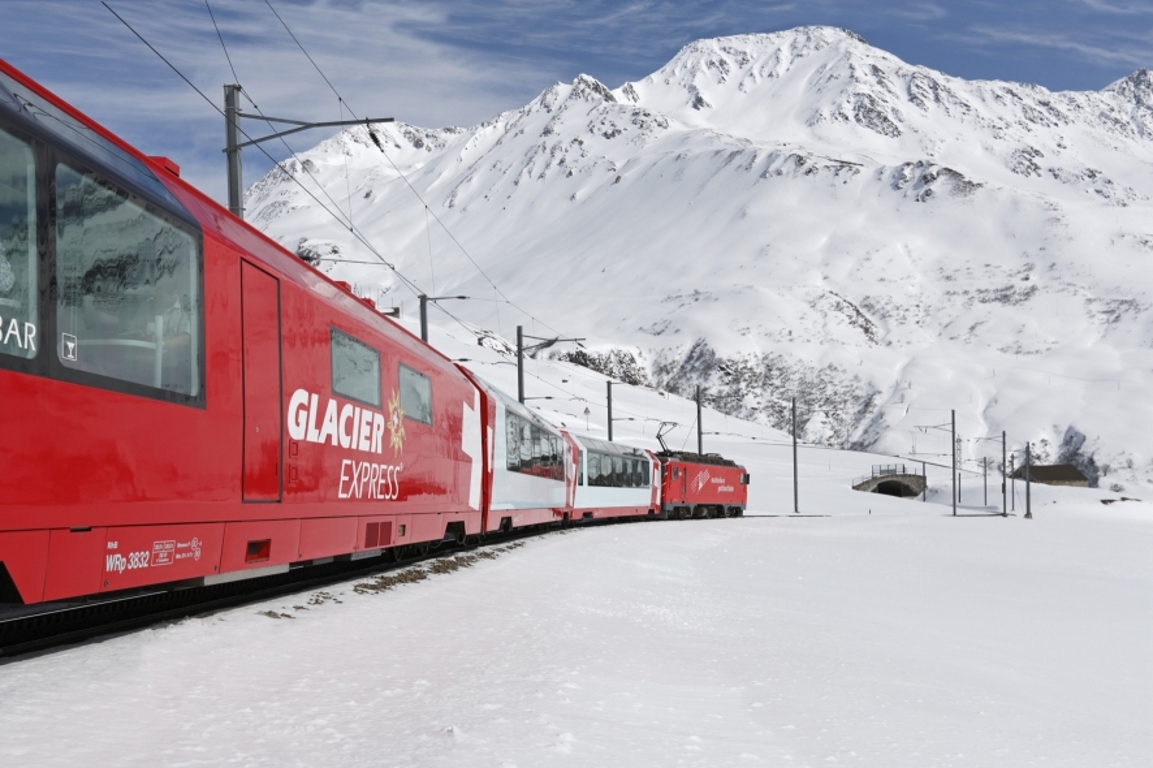
Trains are the most important means of transportation within Switzerland and with neighboring countries. The road network is quite dense. The national railway company of the Swiss Confederation is called Swiss Federal Railways, abbreviated as SBB/CFF/FFS (German/French/Italian respectively). The railway covers the main trunk lines, while the private railways supplement the branch lines between the villages and mountain railways. Routes of the same width can be directly connected. Except for special sightseeing trains or mountain climbing roads, most of the ticketing mechanisms and ticket purchase methods are jointly operated. There will be no problem multiplying. The densely distributed railway network makes it easy to travel to every corner of Switzerland.
Although the development of Swiss railways started relatively late, it only began to develop around 1847. In addition, the territory was surrounded by mountains and mountains, and it was difficult to develop a railway network. However, with the superb railway industry technology and the perseverance of people to conquer the sky, the Swiss authorities finally made Switzerland become The country with the most dense railway network in the world has also become the European railway operation center. The "Eurail Pass" is jointly issued by Switzerland and other European countries.
Traveling in Switzerland by train does not need to spend energy to drive and pay attention to the road conditions, save time than buses, less affected by the weather, and easy to control the traffic schedule. More importantly, most of the railways in Switzerland are built according to the terrain, and you can enjoy the postcards outside the windows. The beautiful scenery is the focus of railway travel.
The Swiss like their trains. The average person travels more than 2,300 kilometers per year by train. 1.2 million people use Swiss trains every day. The Swiss railway network is also the most intensively used system in the world. There are more than 10,000 trains running on a network of 3,100 kilometers every day. The transportation system has more than 1,000 kilometers of mountain railways, more than 13,500 kilometers of bus lines and more than 23,000 bus stops.
Highlights of Swiss Railways
- The highest station in Europe-Jungfrau Station (3454 meters/11,332 feet on the Top of Europe)
- The oldest mountain train in Europe-Vitznau-Rigi, built in 1871
- The longest cogwheel railway in Europe-Wengernalpbahn, 19.2km/11 miles
- The world's steepest cogwheel railway-Pilatusbahn (Pilatusbahn), starting from Alpnachstad and ending at Pilatus, with a maximum slope of 48%, passing through forests, pastures and rock slopes along the way.
- The shortest railway in Switzerland-Marzili Funicular (Bern), 105 meters/344 feet
Swiss Railway Clock
Swiss Railway Clock at Zurich Station
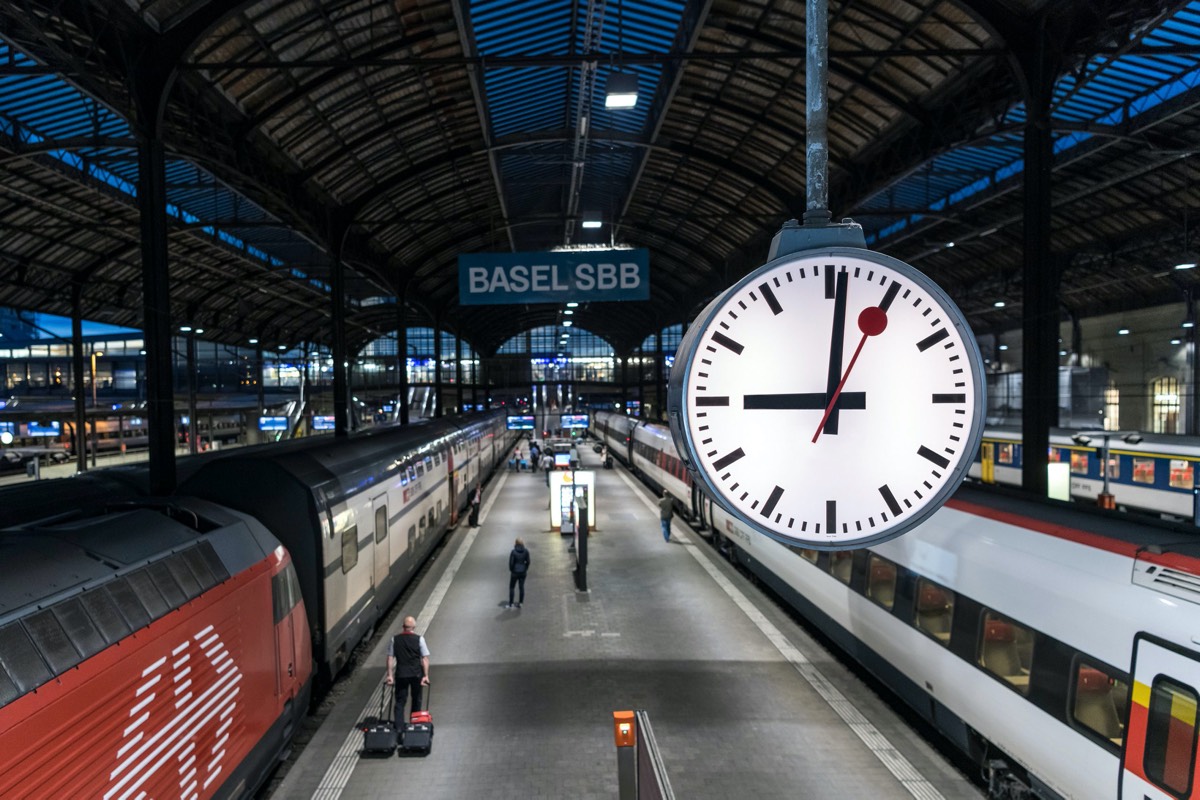
The Swiss Railway Clock (German: Schweizer Bahnhofsuhr) is a clock used by the Swiss Federal Railways at various stations. It was designed in 1944 by the Swiss engineer Hans Hillfek employed by the Swiss Federal Railways and the watch manufacturer Mobatime. In 1953, Hilfeck took the appearance of the railway disc signal as inspiration and added the red second hand on the existing clock face. The Swiss Railway Clock has become one of Switzerland’s national symbols. The Design Museum in London and the Museum of Modern Art in New York both list it as an outstanding design of the twentieth century. The Swiss Railway is also included in the "Swiss Classic Design Series" on Swiss stamps. clock. This clock face design was licensed to Apple in 2012 for use on its iOS products.
This clock is designed to meet the requirements of railway use. The time displayed by different clocks must be coordinated and unified so that passengers and railway staff in the station can know the accurate and reliable time.
Seconds are not listed on the Swiss railway timetable, all trains depart on the hour every minute. For this reason, the clocks of all Swiss Federal Railways stations coordinate and synchronize time by receiving radio waves from a master clock. At the hour of every minute, the main clock will send out an electronic pulse, and the minute hand will advance one division after receiving the signal. The second hand is independently driven by an electric motor, and there is no linkage between the hour and minute hands. It takes about 58.5 seconds for the second hand to make a circle around the clock face, and then stays at the twelve o'clock position briefly until the clock receives the signal every minute before it starts to circle the next time. According to Hilfeck, this short-stop design of the second hand can help trains run on time.
Swiss train ticket discount options can be varied, from half-price cards to multi-day, multi-purpose bus, boat, train, and even bicycle rental tickets. Generally speaking, there is at least one train or bus per hour on each route. Many routes and buses run every 30 minutes or even 15 minutes. During peak hours, there is a city transport every 5-7 minutes. Like all routes in Switzerland, the number of trains will be slightly reduced on weekends, especially on Sundays and public holidays in less populated areas.
Swiss Federal Railways SBB train models
The types of trains included in the Swiss Federal Railways network include:
- Intercity Express (IC, InterCity)/European Intercity Express (EC, EuroCity)
- Intercity Express (ICN, Intercity-Neigezug)
- Interregional Express (IR, Interregional)
- Regional Express (RE, RegioExpress) Regional Train (R, Regionalzug)
- Commuter train (S, S-Bahn)
Domestic train
InterCity Express (IC, InterCity)
Starting on December 9, 2018, Swiss Railways SBB introduced a new long-distance train manufactured by Bombardier with up to 1,300 seats, so it can provide greater traffic on very busy routes. When passing through a tunnel or passing a high-speed train in the opposite direction, the pressure-resistant carriage design reduces the uncomfortable pressure in the ears.
The new trains also use technology to enable them to bypass curves faster in the future, which will also shorten travel time.
SBB's new Bombardier long-distance double-decker train
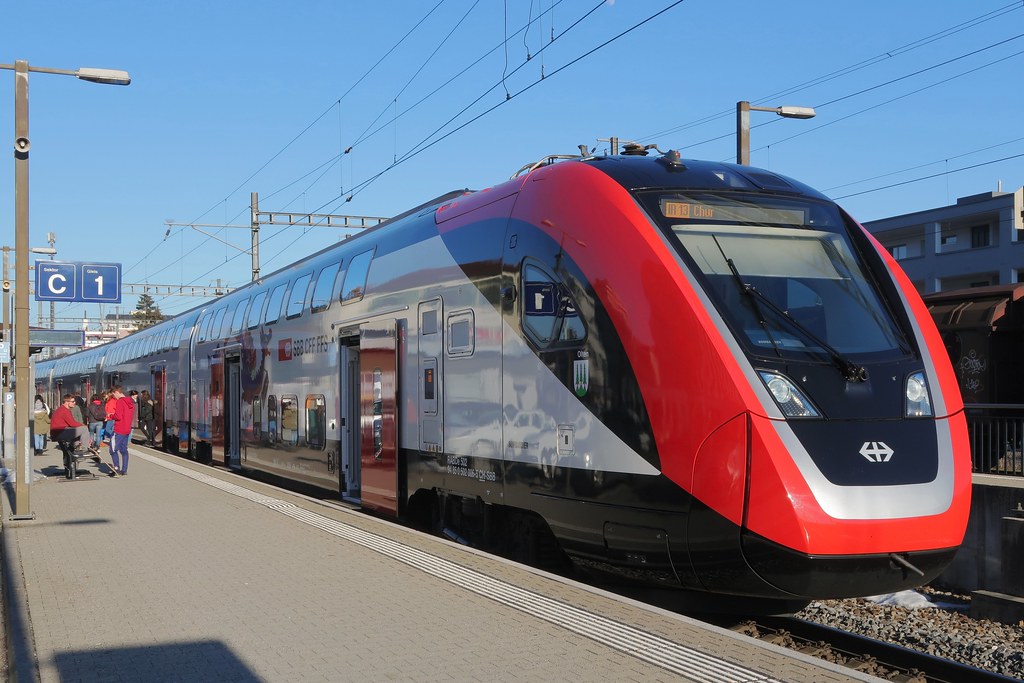
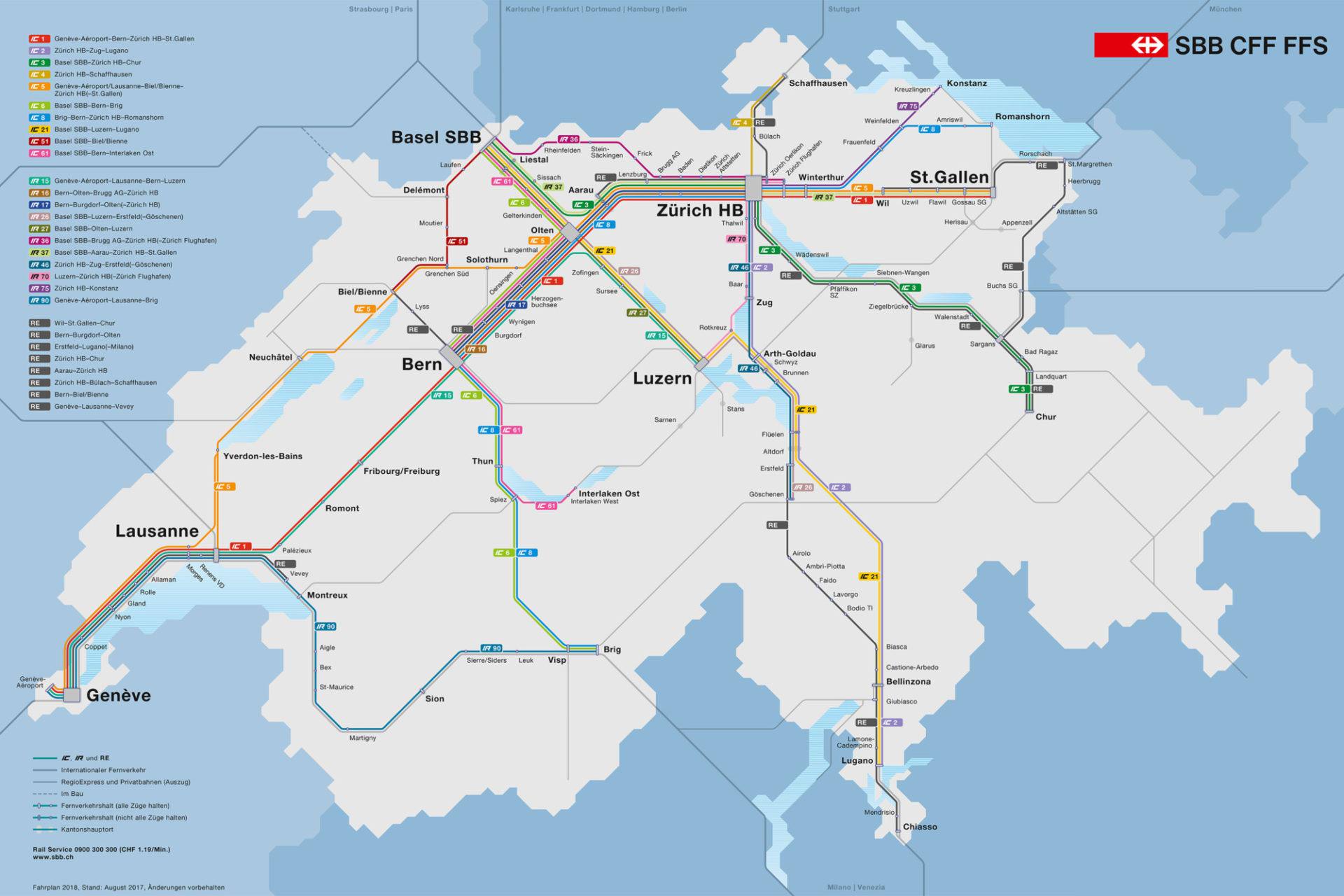
The interior of the train is bright and spacious. There are power sockets next to each seat in the first and second class cabins, wheelchair barrier-free compartments and toilets, toilets with baby changing facilities, and strollers and bicycles laid throughout the train. Specify space. InterCity also has a family cabin (Family Coach) and a dining car (Restuarant Coach). There is also InterCity with Starbucks carriages.
SBB Intercity Train First Class
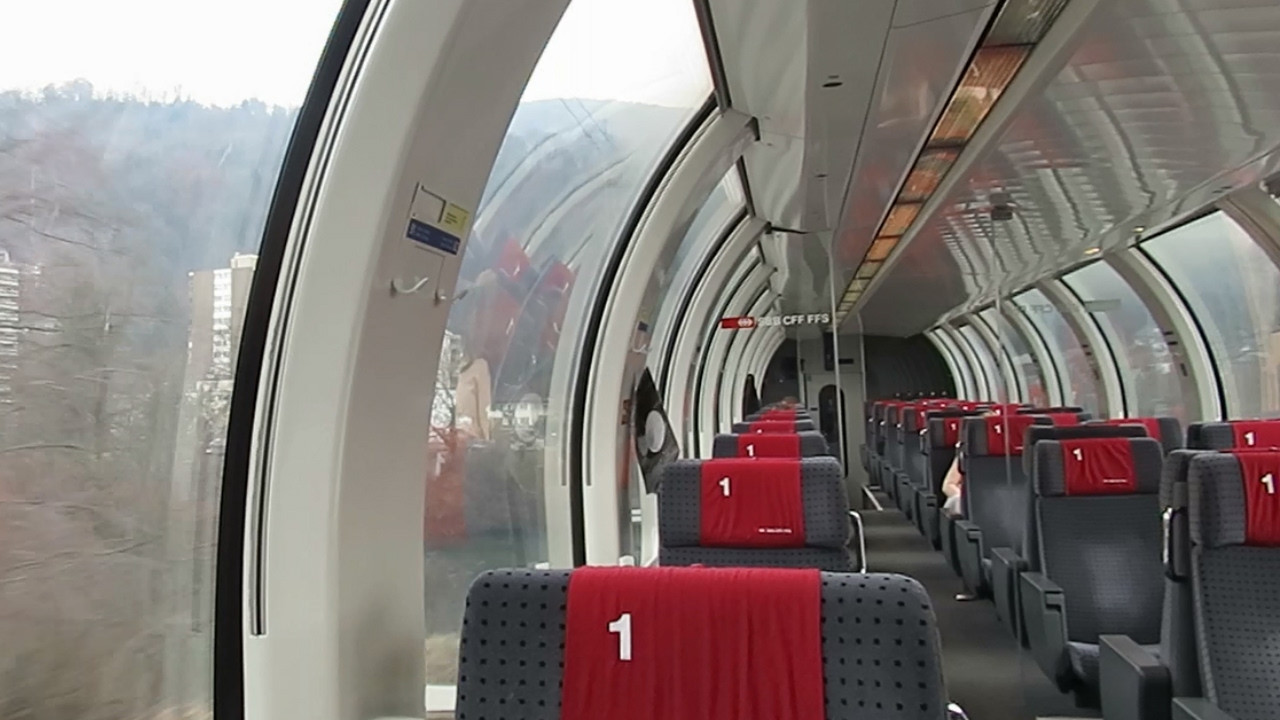
Children's playground in SBB InterCity family carriage
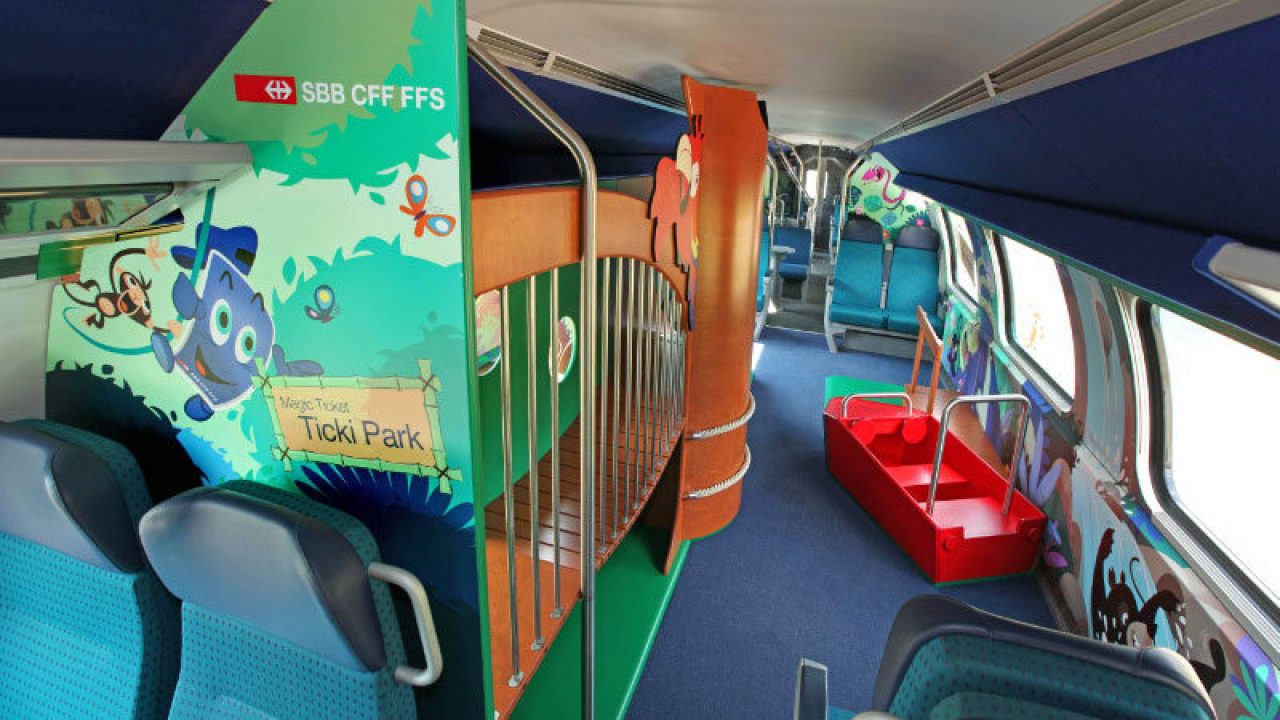
Swiss Railways SBB InterCity (InterCity) Starbucks carriage
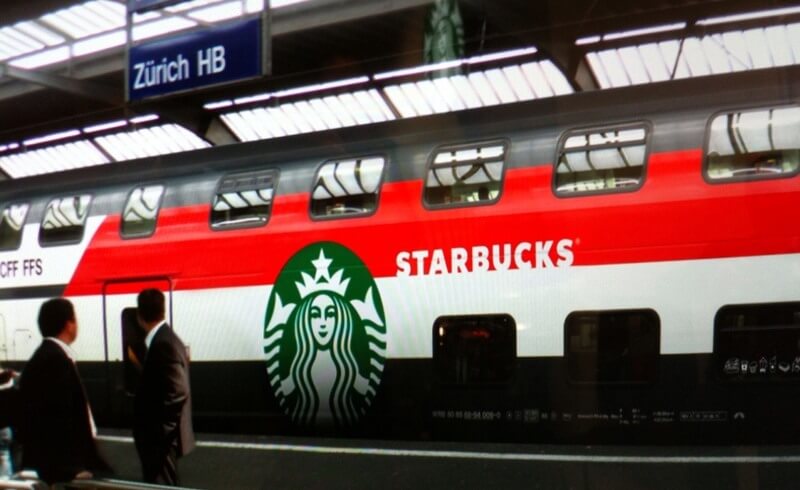
Interior view of the Starbucks compartment of the Swiss Railway SBB InterCity
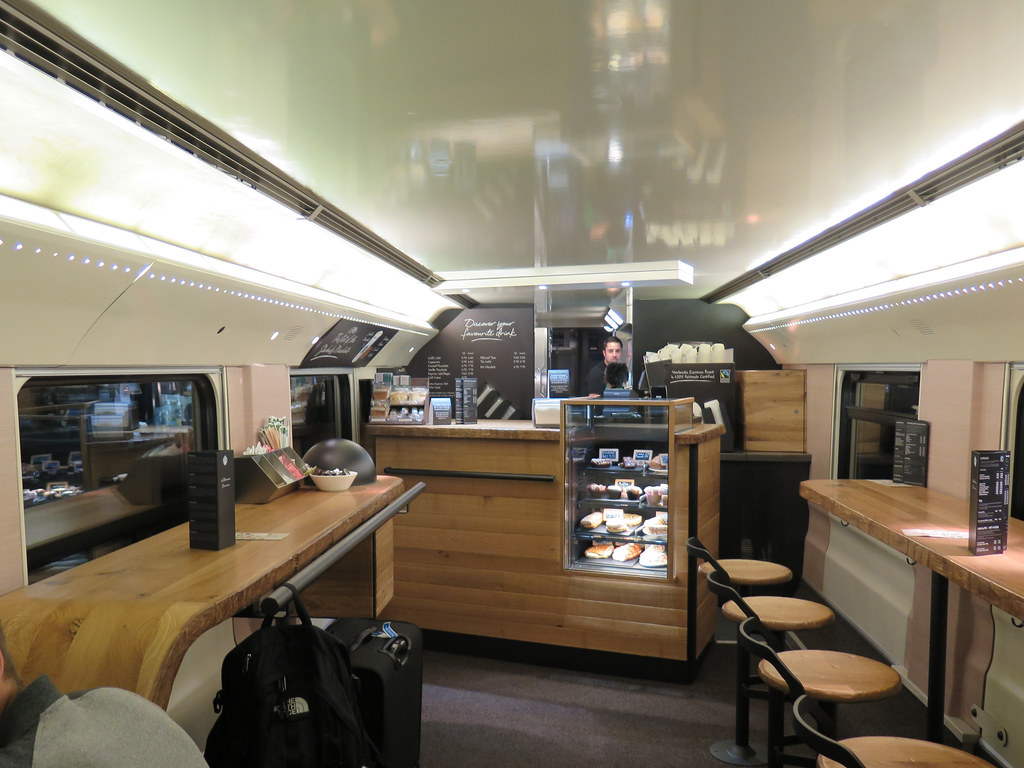
Interregional Express (IR, Interregional)
Interregio trains operated by SBB (Swiss Railways) are long-distance trains that complement the inter-city network. They run between major cities and various minor cities. The speed of medium-distance express trains is second only to IC. The advantages of fast speed, fewer stops and frequent shifts. Compared to Intercity services, Interregio usually runs on shorter routes and stops more frequently.
Interregio trains usually consist of traditional push-pull harrows consisting of single or double-deck passenger cars or double-deck railway vehicles. They arrange second- and first-class seats in open seats. All trains have air conditioning and electrical outlets. The train has a tavern or restaurant car. All trains have facilities for the disabled. Bicycles can be transported on all trains. But it is not possible to reserve seats.
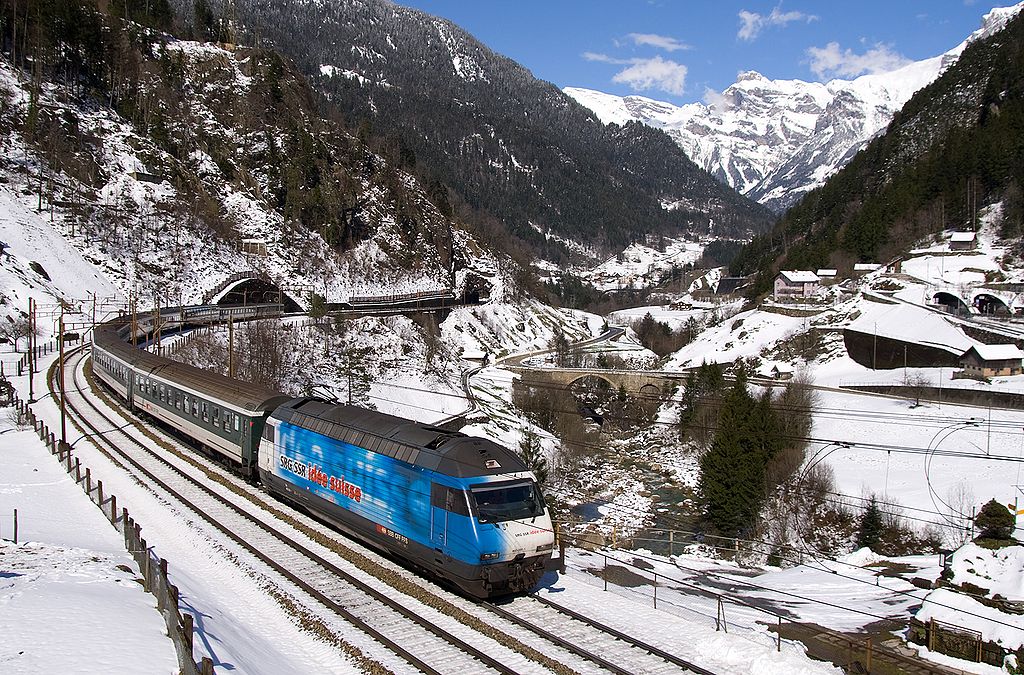

Regional Express (RE, RegioExpress)
RegioExpress is a fast regional train in Switzerland, operated by Swiss Federal Railways or other private railway companies (such as BLS, z. B. Berne-Luzern or Lötschberger on the Lötschberg mountain route and the Rhaetian Railway (RhB)). It is comparable to the regional express trains in Germany, Austria and Luxembourg.
The speed of RE is much faster than regional trains of the same level because it does not stop at all stations served by regional trains. Nevertheless, it is slightly slower than the InterRegio train. The Swiss Federal Railways describes these trains as "quickly entering the area" trains.
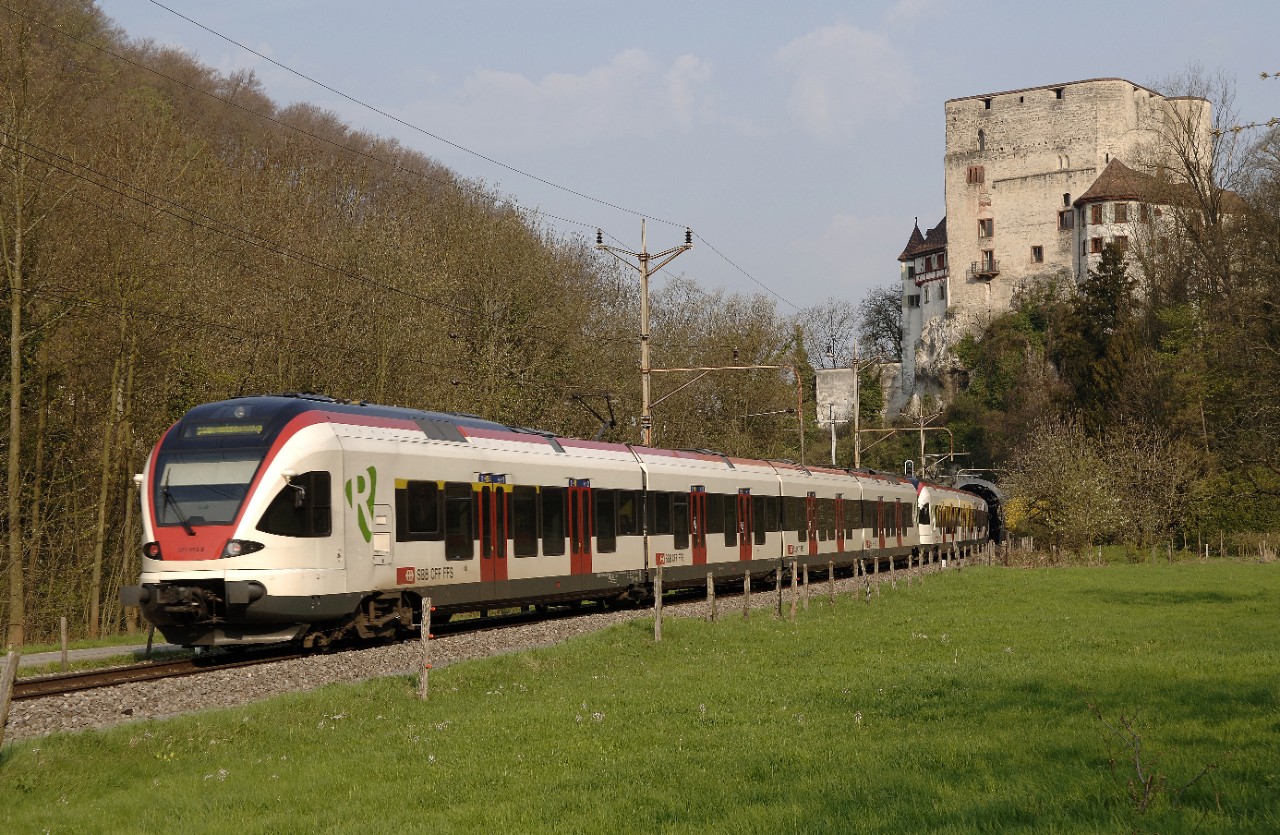
Regional train (R, Regionalzug)
Regional trains (R, Regionalzug) will stop at all railway stations in the area and are slow trains.
If you want to go to a small town, you can take a faster train such as SBB regional express (IR, Interregional), intercity express (IC, InterCity), etc., to the main local station (such as Lausanne) to arrive there. Area, then transfer to the R train to the last station.
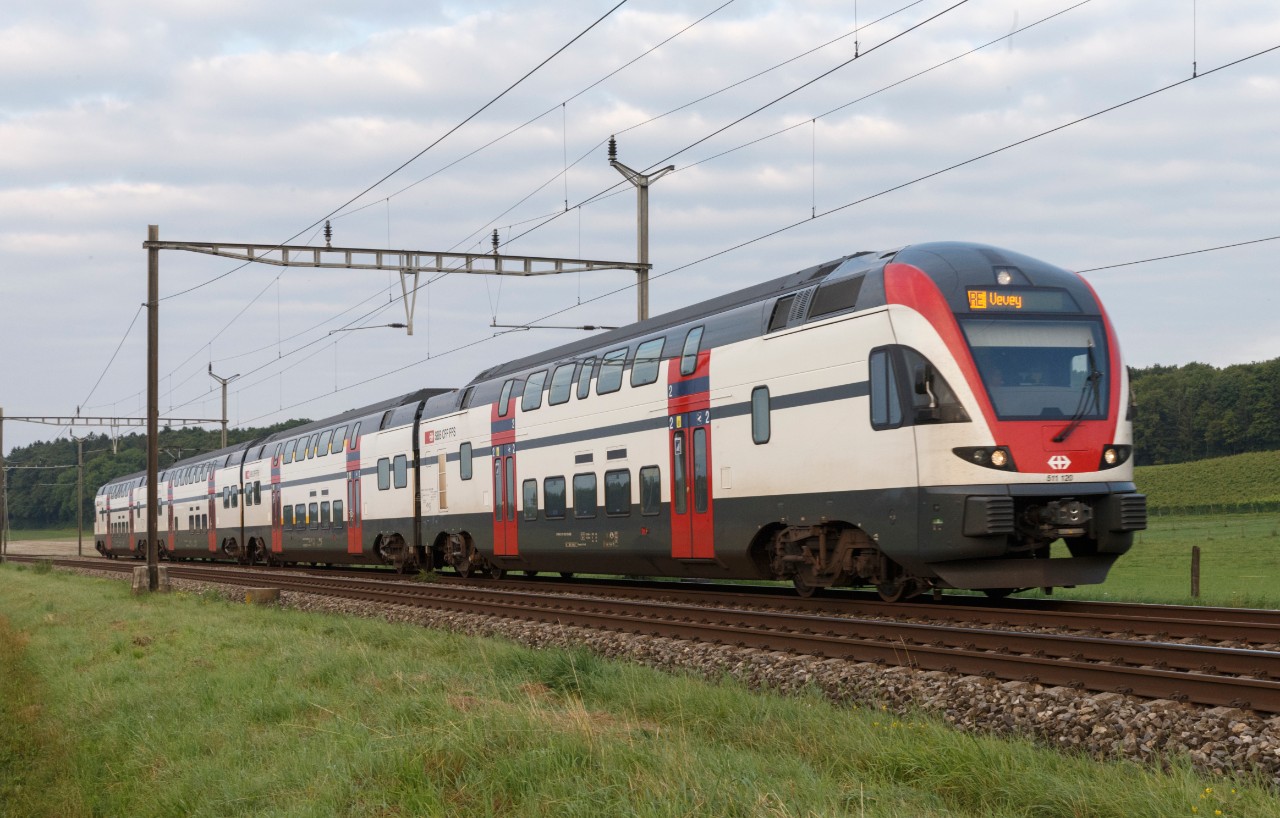
Commuter Train (S, S-Bahn)
S-Bahn is organized as a rapid transit system around the main agglomeration area, with many lines, usually with a dense number of trains.
BLS train company Berne S-Bahn (S5 line)
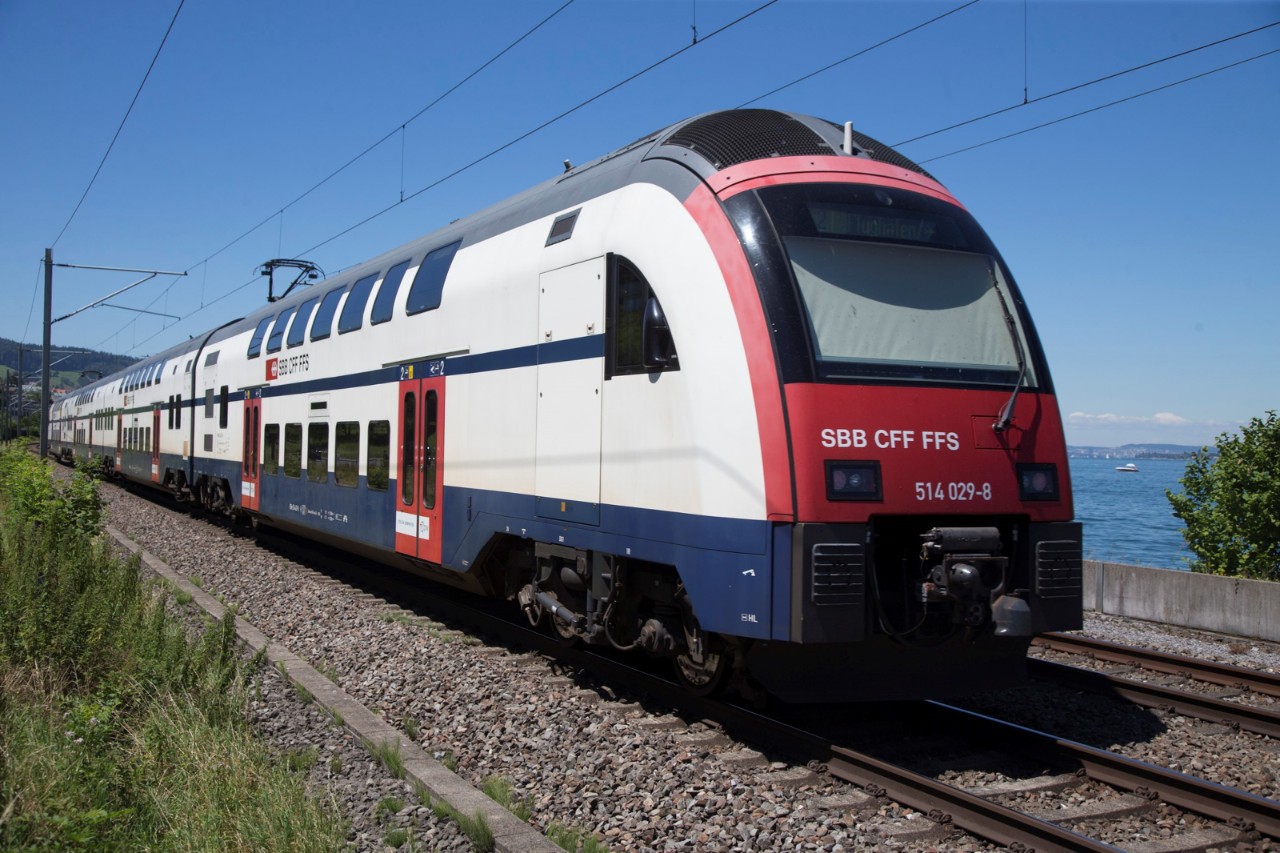
International Train
European Intercity Express (EC, EuroCity)
The European Intercity Express (EC, EuroCity) is a long-distance transnational train in Europe that meets 20 international service standards, including comfort, speed, catering services and cleanliness. The European Intercity Express is operated by a number of EU countries or Swiss railway companies to connect important European cities.
SBB Train's European Intercity Express (EC, EuroCity)
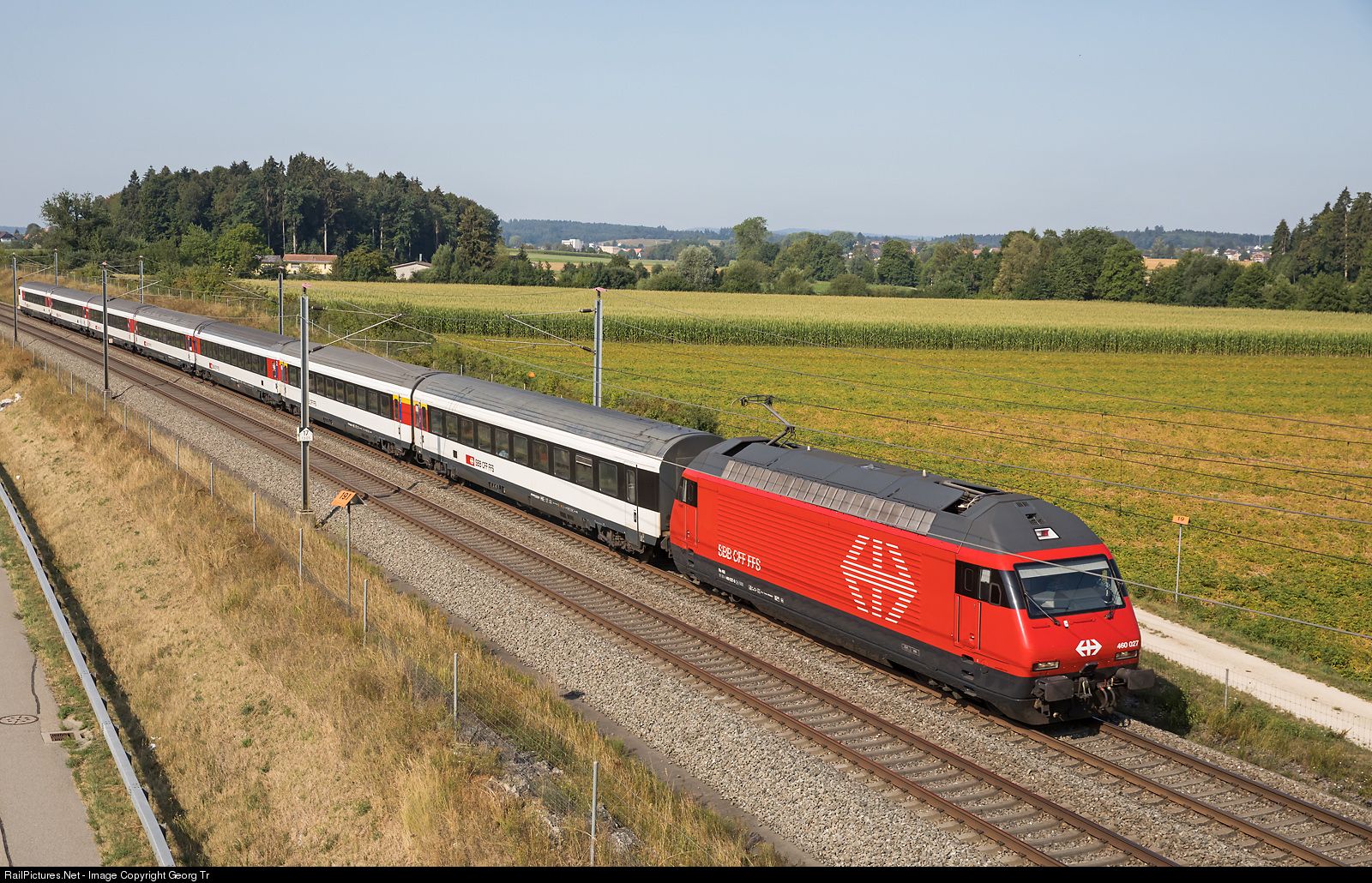
Swiss SBB EuroCity main cross-border train routes
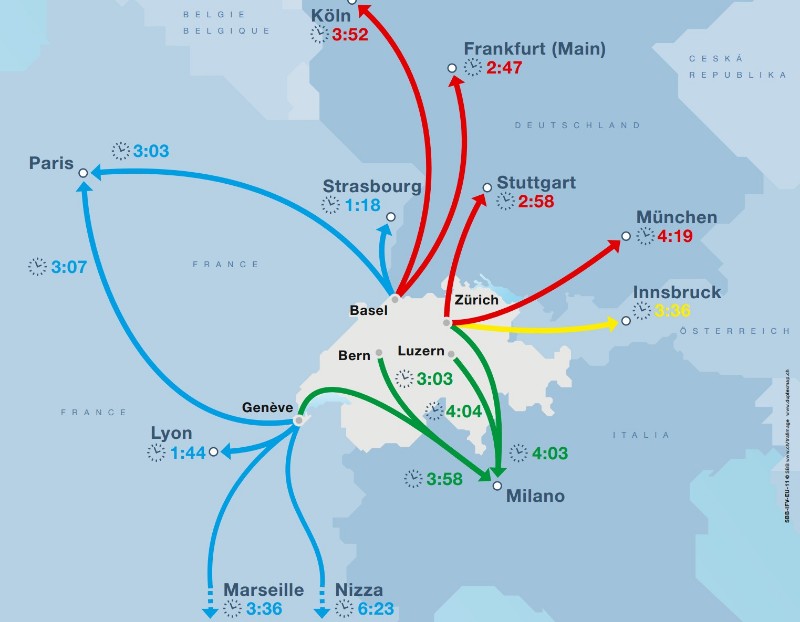
The standards that EuroCity trains require to meet include:
- The train route passes through two or more countries
- All trains are air-conditioned
- Only stop at stations in major cities
- Stopping time does not exceed five minutes, and under special circumstances does not exceed 15 minutes
- Food and drinks are provided in the car (preferably with a dining car)
- The captain speaks at least two languages, one of which must be English, French or German
- Average speed (including stops) is higher than 90 kilometers per hour
Swiss Federal Railways SBB main models
The types of trains included in the Swiss Federal Railways network include:
- Intercity Express (IC, InterCity)/European Intercity Express (EC, EuroCity)
- Intercity Express (ICN, Intercity-Neigezug)
- Interregional Express (IR, Interregional)
- Regional Express (RE, RegioExpress) Regional Train (R, Regionalzug)
- Commuter train (S, S-Bahn)
Domestic train
InterCity Express (IC, InterCity)
Starting on December 9, 2018, Swiss Railways SBB introduced a new long-distance train manufactured by Bombardier with up to 1,300 seats, so it can provide greater traffic on very busy routes. When passing through a tunnel or passing a high-speed train in the opposite direction, the pressure-resistant carriage design reduces the uncomfortable pressure in the ears.
The new trains also use technology to enable them to bypass curves faster in the future, which will also shorten travel time.
SBB's new Bombardier long-distance double-decker train


The interior of the train is bright and spacious. There are power sockets next to each seat in the first and second class cabins, wheelchair barrier-free compartments and toilets, toilets with baby changing facilities, and strollers and bicycles laid throughout the train. Specify space. InterCity also has a family cabin (Family Coach) and a dining car (Restuarant Coach). There is also InterCity with Starbucks carriages.
SBB Intercity Train First Class

Children's playground in SBB InterCity family carriage

Swiss Railways SBB InterCity (InterCity) Starbucks carriage

Interior view of the Starbucks compartment of the Swiss Railway SBB InterCity

Interregional Express (IR, Interregional)
Interregio trains operated by SBB (Swiss Railways) are long-distance trains that complement the inter-city network. They run between major cities and various minor cities. The speed of medium-distance express trains is second only to IC. The advantages of fast speed, fewer stops and frequent shifts. Compared to Intercity services, Interregio usually runs on shorter routes and stops more frequently.
Interregio trains usually consist of traditional push-pull harrows consisting of single or double-deck passenger cars or double-deck railway vehicles. They arrange second- and first-class seats in open seats. All trains have air conditioning and electrical outlets. The train has a tavern or restaurant car. All trains have facilities for the disabled. Bicycles can be transported on all trains. But it is not possible to reserve seats.


Regional Express (RE, RegioExpress)
RegioExpress is a fast regional train in Switzerland, operated by Swiss Federal Railways or other private railway companies (such as BLS, z. B. Berne-Luzern or Lötschberger on the Lötschberg mountain route and the Rhaetian Railway (RhB)). It is comparable to the regional express trains in Germany, Austria and Luxembourg.
The speed of RE is much faster than regional trains of the same level because it does not stop at all stations served by regional trains. Nevertheless, it is slightly slower than the InterRegio train. The Swiss Federal Railways describes these trains as "quickly entering the area" trains.

Regional train (R, Regionalzug)
Regional trains (R, Regionalzug) will stop at all railway stations in the area and are slow trains.
If you want to go to a small town, you can take a faster train such as SBB regional express (IR, Interregional), intercity express (IC, InterCity), etc., to the main local station (such as Lausanne) to arrive there. Area, then transfer to the R train to the last station.

Commuter Train (S, S-Bahn)
S-Bahn is organized as a rapid transit system around the main agglomeration area, with many lines, usually with a dense number of trains.
BLS train company Berne S-Bahn (S5 line)

International Train
European Intercity Express (EC, EuroCity)
The European Intercity Express (EC, EuroCity) is a long-distance transnational train in Europe that meets 20 international service standards, including comfort, speed, catering services and cleanliness. The European Intercity Express is operated by a number of EU countries or Swiss railway companies to connect important European cities.
SBB Train's European Intercity Express (EC, EuroCity)

Swiss SBB EuroCity main cross-border train routes

The standards that EuroCity trains require to meet include:
- The train route passes through two or more countries
- All trains are air-conditioned
- Only stop at stations in major cities
- Stopping time does not exceed five minutes, and under special circumstances does not exceed 15 minutes
- Food and drinks are provided in the car (preferably with a dining car)
- The captain speaks at least two languages, one of which must be English, French or German
- Average speed (including stops) is higher than 90 kilometers per hour
Gornergrat Cog Rail
Gonagrat mountain train in front of the Matterhorn
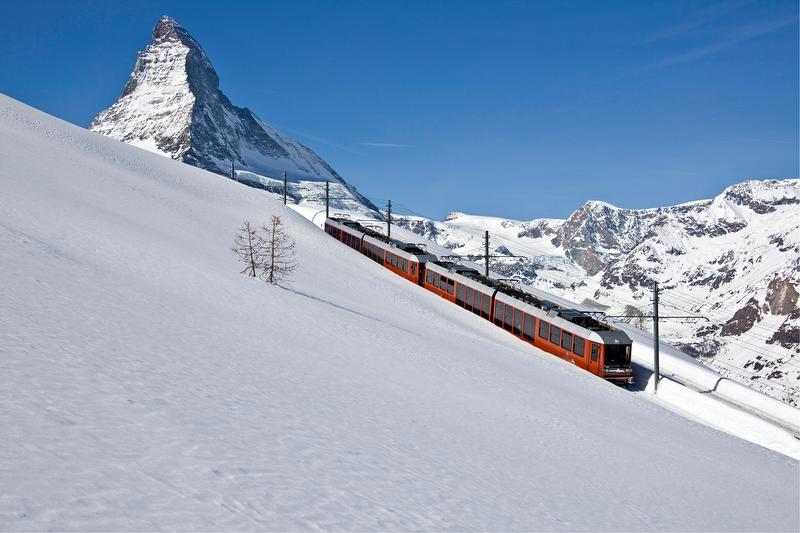
If you want to experience the wonderland-like beauty of the Alps, you must take the Gonagrat mountain train! The sun-drenched Gonagrat Observatory is open all year round. Here you can observe 29 majestic peaks with an elevation of more than 4,000 meters, and overlook the second longest glacier in the Alps, and feel the unparalleled majesty.
The famous Tablerone chocolate comes from Matterhorn

The climbing slope of the Gonagrat mountain train is 200 per thousand, allowing you to easily climb 1,469 meters while enjoying the beautiful scenery. Riding the Gonagrat mountain train in summer is a very pleasant experience. The grass outside the window is covered with a variety of special flowers from the Alps, dotted with a landscape painting. The special fragrance attracts many butterflies around, and it spreads from time to time in the valley. With the crisp sound of cow bells, along with the appearance of the Matterhorn, there are endless surprises along the way. Refreshing
The Gonagrat mountain train takes about 30 minutes to reach the Kurgaurat Hotel at the terminal station, which is also the highest hotel in Switzerland, where you can enjoy the spectacular scenery to your heart's content. The Gonagrat mountain train is suitable for all kinds of activities along the way. Whether it is walking, hiking, or cycling, you can enjoy the purest nature. In summer, the Riffelsee is crystal clear, reflecting the Matterhorn, making you linger.
From Gona Grat Observation Deck, you can admire 29 majestic peaks over 4,000 meters, including the highest peak Dufour, and the most famous Matterhorn. The observation deck surrounded by mountains allows you It's like being in heaven. When you come here, you must wake up early to watch the sunrise on the Matterhorn, or experience the wonderful feeling of skiing in the moonlight. From the peaks of Mount Rosa to the Matterhorn, these snow-covered mountains all year round, you can overlook many glaciers, especially the Gona Glacier, the second longest in the Alps. In winter, get off from Liefelberg and follow the trail to the Glacier Garden. Get off from Rothenboden. You can experience the activities of crossing the glacier, find the source of the glacier, and reach the mountain hut on the top of the glacier. Polluted nature.
Centovalli Railway
The scenic route runs through Centovalli (meaning "100 valleys" in Italian), showing another kind of Switzerland: rock canyons, quaint stone villages and many waterfalls. Riding this train is either a day trip or a good place from southwestern Switzerland (Geneva, Montreux, Zermatt) to southeastern Switzerland (Locarno, Lugano, St. Moritz).
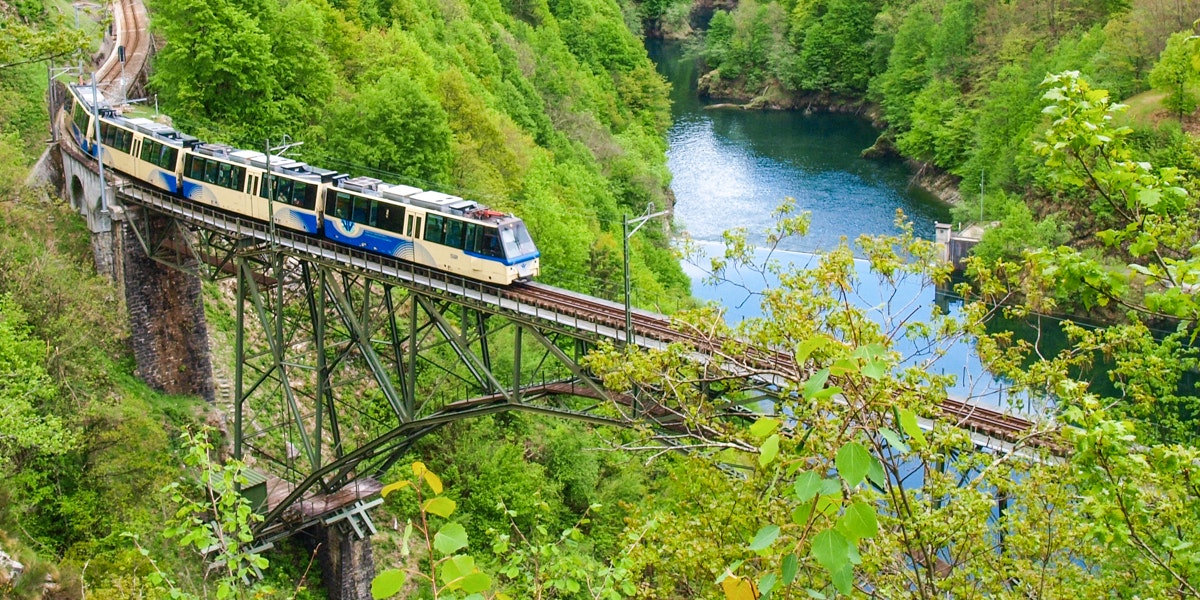
The Centovalli train runs between the small Italian town of Domodossola and Locarno in the Swiss canton of Ticino. It crosses 83 bridges, 31 tunnels and many waterfalls, winding through the narrow valleys of the area.
There are two types of trains on this route. The most attractive is the Treno Panoramico Vigezzo Vision with panoramic windows. In addition, there is a more standard train called Centovalli Express. Both trains run slowly, but you can have a pleasant experience, soak up the scenery and take pictures.
If you take Treno Panoramico Vigezzo Vision, there is a special seat next to the driver in the first train car. Very suitable for photographers and videographers! This train also provides catering services for snacks and drinks.
Driver's perspective on Centovalli Railway

Route map of Centovalli Railway

Pilatus Cogwheel Rail
The Pilatus Cog Train is the steepest cog train in the world

Pilatus Railway (German: Pilatusbahn, PB) is a mountain railway in Switzerland. It is the steepest railway track in the world, with a maximum gradient of 48% and an average gradient of 35%. The line runs from Alpnachstad on Lake Lucerne to a terminal near the top of the Esel summit in Pilatus at an altitude of 2,073 meters (6,801 feet), making it the highest railway in Obwalden.
Pilatus railway route map

Globi Express (Globi-Express, Swiss parent-child train)
On the Central Railway in Switzerland, it’s hard not to be attracted by the train with the cartoon image of Globi. The picture of Grubi jumping among the Swiss lakes and mountains and the Alps is exciting. Designed by Ruby's family and travelers.
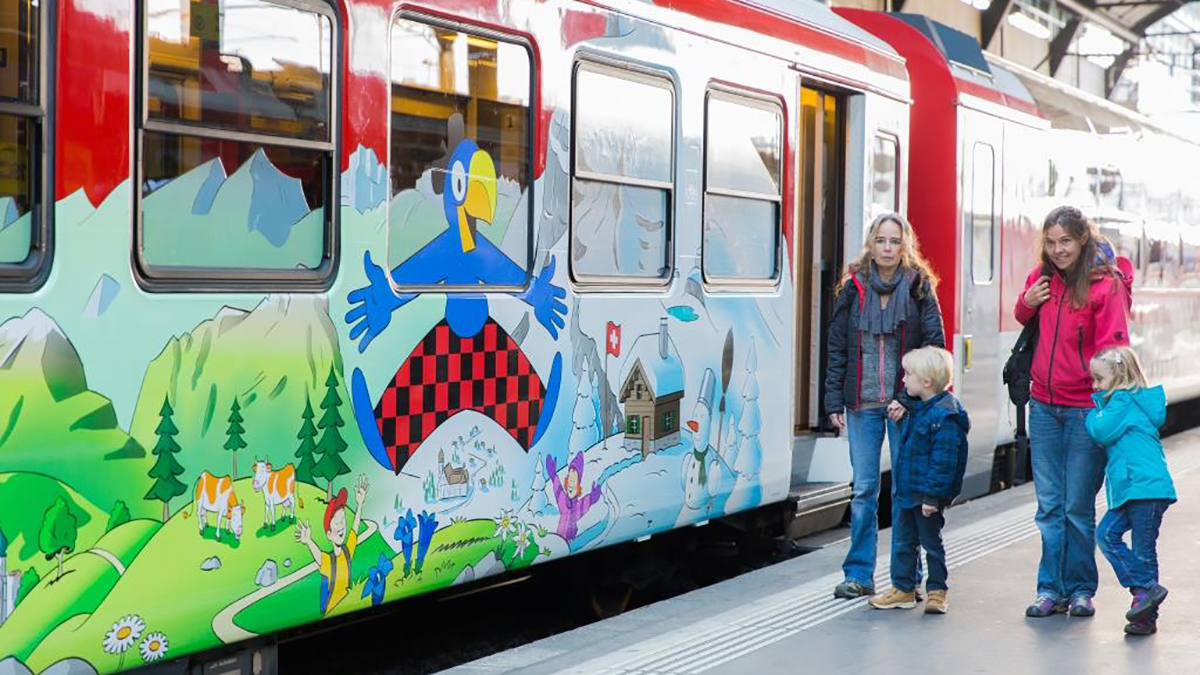
The Globi Express is a route from Lucerne to Engelberg. Swiss Railways and the Swiss Publishing House of Zurich collaborated to create this new design. The carriage has been transformed into a red and black grid with the image of Gruby, with the usual dark blue seats of the Swiss Railway, giving the illusion that bird-shaped people are everywhere.
Books about Gruby in the carriage can be found at any time. Many pictures related to Gruby between Lucerne and Engelberg have become classic activities held in different seasons, and children can start their adventures with it. . In order to be more interactive, the train has also designed many small questions related to the pictures. As long as you answer 4 of the 6 answers correctly, you can receive a beautiful gift after arriving at Engelberg Station. Because of the addition of Gruby, the atmosphere of the entire carriage has become more enthusiastic and the journey has also become short-lived in the game and joy.
Chocolate Train (Chocolate Train)
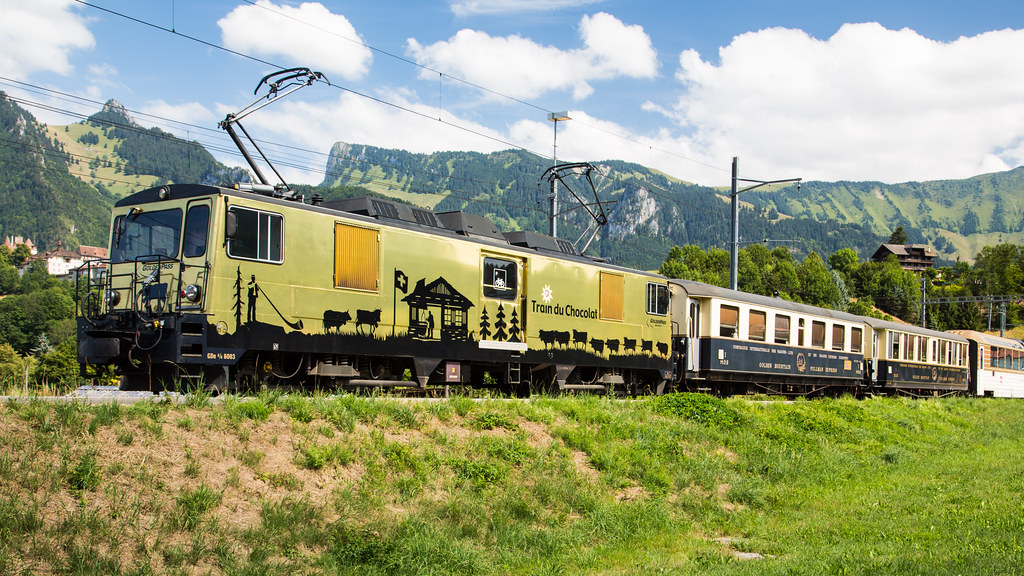
If you don't taste Switzerland's most famous specialty-Swiss chocolate, you won't be counted as having visited Switzerland. The Montreux-Berner Oberland Railway provides a train dedicated to the most refined temptations in the world. The chocolate train is only first-class and will take you to the "Maison du Gruyère", where you will be shown the secrets of the production of this famous Swiss cheese.
Cheese Train (Train du Fromage, Cheese Train)
In winter, a special train from Montreux to Bernese Oberland will depart from the highland region (Pays-d’Enhaut) in the Lake Geneva region. Every Thursday to Sunday, the Cheese Express (Train du Fromage) runs between Montreux and Daiburgh in the Lake Geneva region.
The top of the cheese train is light yellow, and the bottom is dark blue. After the train departs, the conductor will carry a large plate of assorted cheeses for passengers to choose from, accompanied by a glass of Swiss wine. Daiburgh, located in the Sarine Valley, has excellent water resources. Since hundreds of years ago, herders there have known how to make delicious Alpine cheeses, thick or light, some mixed with hazelnuts, and some fused The taste of fruit. Passengers on the cheese train can learn about how 200 liters of milk turns into cheese at the "Le Chalet Bio" cheese shop in Daiburgh, and taste the delicious green eco-cheese fondue at the restaurant inside the shop. Finally, visitors can also go to the Plateau Regional Museum (Museumdu Pays-d'Enhaut) to appreciate the colorful collection of traditional paper-cuts.
Arosa Express

The Arosa Express is a smaller version of the Brenna train. Except that the two parties are operated by the same railway company, the route also starts from Chur City, passing through canyons, villages, woods, bridges, tunnels, and lakes along the road. It takes just one hour to drive to the terminal station at an altitude of 1793-Qingyou Arosa, the resort of Arosa, is surrounded by mountains and waters. In summer, it is a resort for many people to cultivate their bodies and minds. In winter, it is a ski paradise for young people.
Operation period: All year round, the timetable changes according to each season.
Total time: about 1 hour
Traveling route: Chur-Arosa
Pre-Alpline Express
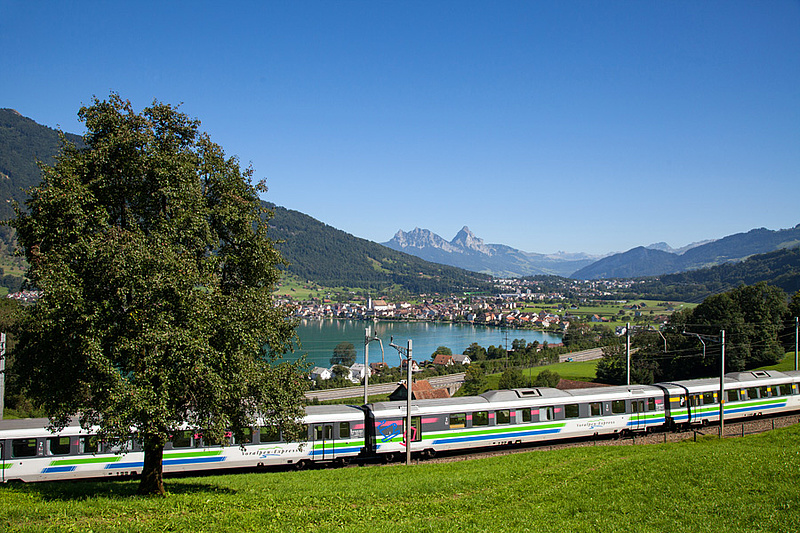
The Pre-Alpine Express train from Lucerne heads northeast to the Baden Lake Boensee on the border of Germany. Running along the foothills of the Alps, in addition to enjoying the beautiful views of the Alps, you will also pass several well-known monasteries, such as Einsiedeln Collegiate Church and St. Gallen Abbey ST.Gall Church. You can also visit the Convent of St Gall and Abbey Library, which is listed as a World Heritage Site for its collection of hand-written scriptures. To the terminal Romanshorn Romanshorn can also take a boat trip on Lake Baden.
Operation period: All year round, the timetable changes according to each season.
Total time: about 3 hours
Route: Luzern-St. Gallen-Romanshorn
Train Types
Ticket
Swiss public transport fares will not change until two years or more, and may even remain unchanged for ten years. This is not surprising, because changes in fares can easily become widely discussed political issues and are often voted by the public. Therefore, Swiss people usually buy tickets a few minutes before departure, if they do not have children or travel cards (many people do) or do not buy them online for convenience. So you can also buy a point-to-point ticket in Switzerland 30 days before departure.
There is only one exception: limited-time special tickets are only sold online and are only valid for specific routes, so you need to buy online early. You can buy it directly from the xmove App, or go to G2Rail.
Fare Zone (Tarifzonen, Fare Zone)
Swiss fare zone (Tarifzonen, Fare Zone)
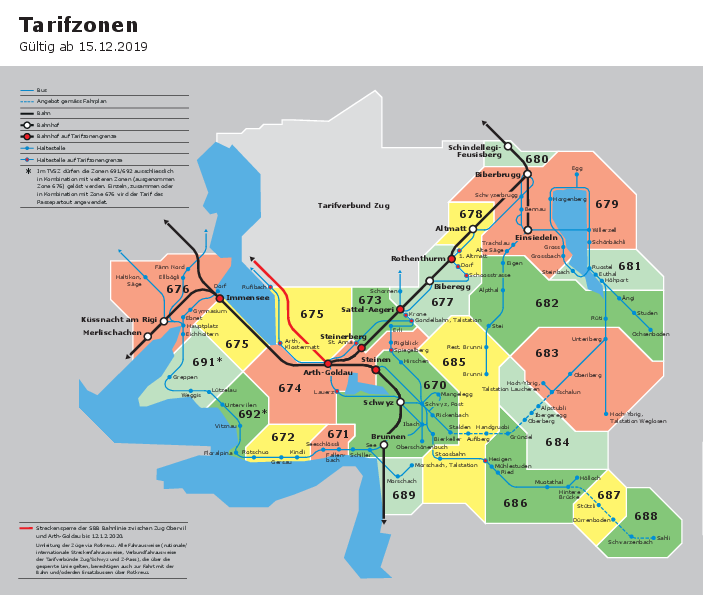
Swiss buses and trains are not legally allowed to compete with each other, on the contrary, they complement each other-in addition to coordinated timetables. In this way, almost all inhabited Swiss villages and towns can be reached by public transport.
There are about twenty regional fare networks across the country, which combine multiple public transportation (city buses, trams, subways, any type of trains, post offices, boats, cable cars, etc.) from many different providers around the city center into a single Fare systems such as ZVV in the canton of Zurich, or unireso in the canton of Geneva and its neighbours in France (see also: tpg in Geneva), or mobilis around Lausanne in the canton of Vaud, Lake Geneva, the canton of Lucerne, the Nieder and Obwalden State passepartout (keywords: Titlis, Titlis). Typically, these networks sell area-based passes (rather than point-to-point tickets) that are valid within a certain time frame for journeys within the fare network.
Even if there is no train or city public transportation, the comprehensive PostAuto/CarPostale/AutoPostale network can help you. If applicable, PostBus Switzerland is part of the regional fare network.
Ticket validity period
Standard domestic train tickets are usually valid on the same day until the end of the day's service (starting at 5 a.m. the next day), but only for one journey on the selected route! Moreover, under normal circumstances, you can make a stop at the intermediate stop and continue later on the same day.
The exception is the limited time special ticket of SBB CFF FFS, which is only valid for specific connections.
Usually, tickets are sold for integrating routes of different providers and/or different kinds of transportation. Tickets sold on routes within the boundary of the ticket network are usually based on area rather than point-to-point tickets, so they are valid for any route reserved in a designated area, and valid for a specific time frame, and generally apply to any number of journeys in that segment Time (for example, 1/2 hour, 1 hour, 2 hours, or the entire calendar day, or even 24 hours of a single ticket). Different fare networks may have different terms, although they are usually very similar or sometimes even the same.
Generally speaking, a standard domestic train ticket is always applicable to any type of train, which also includes tourist trains (reservation is likely to be required) and international trains, as long as these trains use the same route as shown on your ticket and you You can only travel between Swiss railway stations.
International tickets for cross-border trains crossing the Swiss border usually have completely different validity and are usually limited to specific trains and/or train types. But in the Swiss railway system, they usually have at least the same validity as domestic air tickets, and are often valid even for more than one day. But please check their specific situation carefully.
Ticket selection
If you plan to stay in Switzerland for a few days and plan a lot of itineraries, it is recommended that you go to the Swiss Rail Pass (Swiss Rail Pass). You will save money because point-to-point tickets are usually more expensive. You can choose the following passes in Switzerland, which can save a lot of transportation costs.
Swiss Pass
This is your one-stop ticket to travel via Swiss railway, road and waterway. You can travel as you like. Not only can you travel without restrictions, you can also use the Swiss Pass at the entrance to enjoy free discounts at many museums, as well as discounts on Swiss panoramic trains, mountain gear wheels and trains. Cable car. This pass is only valid in Switzerland.
Day ticket, city area pass
Effective for cities or regions. Those who intend to explore urban areas. For example, Zurich Card (Zürich Card)
This allows unlimited second-class travel by bus, train and cable TV in and around Zurich. Similar transportation cards are also available in other major Swiss cities and regions.
Day ticket, 9 o’clock pass (9 o’clock pass, 9-Uhr-Pass)
In the Zurich area, you have an additional option: the 9-Uhr-Pass. Allows you to travel freely throughout the canton of Zurich (including boats, trains, buses and trams), only 25-Swiss francs. The only condition: On working days, you can start your journey after 9 o'clock. This is how the pass gets its name. On weekends, the pass is valid from the beginning of the service.
Discount card
Few people in Switzerland pay the full price for the transportation system. At least they all have a half-price card (French: abonnement demi-tarif, German: Halbtax-Subscription, Italian: abbonamentomemetà-prezzo), you can save 50% on buses and trains of all countries, and there are also discounts on local private transportation systems. Press the "1/2" (or tariff discount, price reduction, mileage price) button on the ticket vending machine to indicate that you have this card and are ready to hand it to the conductor along with your ticket on the train. The annual half-price card costs 185 Swiss francs; visitors from abroad can purchase a one-month Swiss half-price card for 120 francs. The round-trip ticket from Zurich to Lugano can save 66 francs, so the travel mileage is more, it will quickly be worth the cost.
Reservation
Reservation, is it necessary? When?
In general, except for peak hours (departure time is about 06:30-08:00, about 17:00-18:30), you can always find a free seat, especially in the non-stop between major commercial cities It connects with its suburbs, especially between Zurich and Bern, between Zurich and Basel, and between Lausanne and Geneva. You can easily view this information through the daily updated statistics based on the occupancy indication online schedule, and it is provided 30 days before departure. So normally, no one makes a reservation.
Strong seat
Generally applicable to high-speed international trains, all international trains, night trains and sightseeing trains. Usually the seat reservation is included in the ticket price. If you use a pass, you must purchase a seat reservation separately.
There are only two trains in Switzerland that require reservations: the Bernina Express (BEX), which runs daily between Chur/Davos and Tirano, and Moritz (St. . Moritz/Glacier Express (GEX) between Davos (Devos) and Zermatt (Zermatt). However, regular (regional) trains use the same route. During peak season, the GoldenPass Line between Montreux and Interlaken and the Gotthard Panorama Express between Luzern and Flüelen Express), and between Flüelen and Lugano/Locarno in southern Ticino through the 135-historical and 15-km-long Gotthard Base Tunnel.
Since the opening of the Gotthard Base Tunnel in 2016, the distance between southern Italy/Switzerland (Milan, Lugano, Locarno, Bellinzona) and northern Switzerland (Lucerne, Zurich, Basel) Transfers are often congested because they are easier and faster. In peak tourist seasons, trains are often full, and passengers who have not reserved seats may be prohibited from boarding. Because SBB does not allow passengers to be occupied by trains running in the longest railway tunnel. Therefore, if necessary, be sure to check the occupancy status of this route and make a reservation!
Recommend Reservation
These trains offer you the possibility to reserve seats, but reservations are not mandatory. For example, InterCity (IC) in Switzerland.
No reservation required
Regional trains called S-Bahns generally do not require or impossible reservations.
Boarding
Find a seat in the car
Most trains do not require reservations, as long as you get on the train, you can sit down. If there are people next to you, remember to politely ask if there is a seat. When taking IC, scenic trains or transnational trains, you'll bother to see that the electronic display board above the seat has the name of the starting and ending station, or the yellow name ticket card is inserted-indicating that there is already a reservation.
Check the ticket
After the train is running, the ticket inspector will start to check the ticket. If you use SwissPass, you may be required to show your passport at the same time. If you buy a Swiss train flexible ticket, you must remember to fill in the date of use when you get on the train, otherwise you may be fined! If you buy a ticket with a half-price card, please present both the ticket and the half-price card.
Get off at the station
There are four-language arrival broadcasts in German, French, English, and Italian. If you are afraid of taking the station, it is best to pay attention to the pre-checked arrival time. In some cars, there are screens showing the name of the upcoming station. The doors of Swiss trains are opened semi-automatically. After the train stops, you can press the green button to open the door. If the door is closed but the green light of the button on the door is still on, just press the button to open the door; some Old-style trains need to be manually rotated or the handle on the door can be opened.
Children and family travel
All intercity trains have special children's train cars. There is a playground on the upper level of the carriage. Children under 6 are free, and children between 6 and 15 years old can enjoy a 50% discount for free. With the Swiss Pass, you can apply for a family card and children can travel for free.
If the parents purchased a juvenile travel card or purchased a Grandchild travel card with their grandparents, children traveling with their parents or grandparents can travel for free. If a parent abroad holds any valid Swiss pass/card/air ticket under the Swiss travel system, the child can get a Swiss family card for free, with the same benefits.
Luggage and luggage lockers
Every Swiss train has enough space for luggage. In theory, there is no limit to the amount of luggage you can take the train, but it is similar to most European trains. Larger suitcases and suitcases can be stored in the luggage rack near the entrance of the train door. Small and medium-sized packaging bags are usually installed above or below the seat. On busy ski weekends, be aware in winter, most of the time the train will soon have heavy ski equipment. Most major railway stations in Switzerland provide self-service luggage lockers.
Wheelchair and stroller
In Switzerland, all trains and all railway stations have facilities to facilitate wheelchair and stroller boarding. For some trains, wheelchairs require assistance to enter the train. There are train staff to assist in boarding or changing trains.
Take your bike and travel with your dog
Many train stations offer bicycle rental services. If you want to take your bicycle on the train, you must purchase a separate bicycle ticket. You can buy tickets at ticket machines, ticket counters or on your mobile phone. Not all trains allow bicycles, and some trains require reservations. Usually, the train with bicycles is marked with a bicycle symbol on the timetable, and if there is space for bicycles, it is marked on the train carriage.



